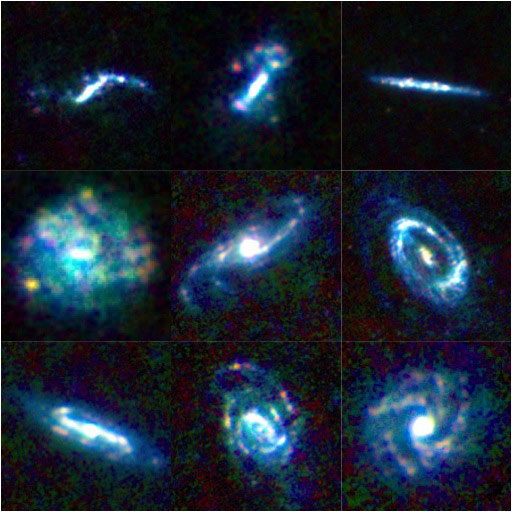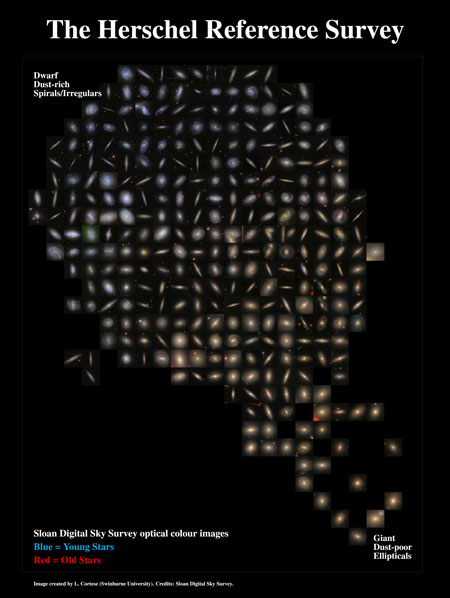| Mar 18, 2014 |
Astronomers complete cosmic dust census
|
|
(Nanowerk News) An international team of astronomers has completed a benchmark study of more than 300 galaxies, producing the largest census of dust in the local Universe, the Herschel Reference Survey. Led by Dr Luca Cortese from Swinburne University of Technology in Melbourne, Australia, the team used the Herschel Space Observatory to observe galaxies at far-infrared and sub-millimetre wavelengths and captured the light directly emitted by dust grains. The results appear in the journal Monthly Notices of the Royal Astronomical Society ("PACS photometry of the Herschel Reference Survey – far-infrared/submillimetre colours as tracers of dust properties in nearby galaxies").
|
 |
| Galaxies in the Herschel Reference Survey. The images are presented in false-colour to highlight different dust temperatures, with blue and red representing colder and warmer regions respectively. (Image: ESA/Herschel/HRS-SAG2 and HeViCS Key Programmes/L. Cortese, Swinburne University)
|
|
“These dust grains are believed to be fundamental ingredients for the formation of stars and planets, but until now very little was known about their abundance and physical properties in galaxies other than our own Milky Way,” said Dr Cortese.
|
|
‘Cosmic dust is heated by starlight to temperatures of only a few tens of degrees above absolute zero, and can thus be only seen at far-infrared/sub-millimetre wavelengths.”
|
|
The two cameras on board the Herschel satellite, SPIRE and PACS, allowed astronomers to probe different frequencies of dust emission, which bear imprints on the physical properties of the grains and therefore were critical for this study. Although the SPIRE data were obtained three years ago, the team had to wait for the completion of the PACS survey last year.
|
 |
| The Herschel Reference Survey at infrared wavelengths. Collage of galaxies in the Herschel Reference Survey, the largest census of cosmic dust in the local Universe. The galaxies are presented in false-colour to highlight different dust temperatures, with blue and red representing colder and warmer regions respectively. The collage is presented with dust-rich, spiral and irregular galaxies in the top left, and giant, dust-poor elliptical galaxies in the bottom-right. The images were composed from PACS and SPIRE observations at 100, 160 and 250 micron. (Credit: ESA/Herschel/HRS-SAG2 and HeViCS Key Programmes/L. Cortese, Swinburne University). (click image to enlarge)
|
|
“The long wait was worthwhile, as the combination of the PACS and SPIRE data shows that the properties of grains vary from one galaxy to another – more than we originally expected. As dust is heated by starlight, we knew that the frequencies at which grains emit should be related to a galaxy’s star formation activity. However, our results show that galaxies’ chemical history plays an equally important role,” commented Dr Cortese.
|
|
Co-author of the work, Dr Jacopo Fritz, from Ghent University in Belgium, said: “This affects our ability to accurately estimate how much dust is in the Universe. It is particularly an issue for the most distant galaxies, which have a star formation and chemical history significantly different to the one in our own Milky Way.”
|
|
The data obtained for the Herschel Reference Survey have been made publicly available to allow further studies of dust properties in nearby galaxies. Although the Herschel Space Telescope completed its mission in April 2013, the combination of data in the Herschel archive, with future observations from the newly commissioned Atacama Large Millimeter/submillimeter Array (ALMA) in Chile, will help astronomers to further unveil the mystery of cosmic dust in galaxies in the years to come.
|


